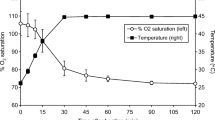Abstract
The dissolution rate of a nicotinic acid tablet surface was measured in a dissolution system where mass transport in the solvent is governed by a combination of natural and forced convection.
While such experimental conditions were chosen that natural convection outweighed forced convection, the dissolution rate increasing effect of large pores in the tablet surface was studied. To that end cylindrical pores were drilled into the tablet. The increase in dissolution rate was measured as a function of the number of pores, their depth and diameter and their position with respect to each other and to the centre of the dissolving surface. The results are discussed with regard to the hydrodynamic conditions near the pores.
In addition to the regularly arranged cylindrical pores a more irregular configuration of cubic pores was investigated. These pores were created by embedding cubic sodium chloride crystals in the tablet surface during the compression procedure. After the sodium chloride particles had dissolved rapidly a porous surface of much slower dissolving nicotinic acid remained. The dissolution rate of the porous surface was determined and a comparison was made between surfaces with and without pores of several sizes.
Similar content being viewed by others
References
European Pharmacopoeia (1969) vol. 1, 173, 331–334;Ibidem (1975) vol. III, 133–134.
Grijseels, H., andC.J. De Blaey (1981)Int. J. Pharm. 9, 337–347.
Grijseels, H., D.J.A. Crommelin andC.J. De Blaey (1981)Pharm. Weekbl. [Sci.] 3, 129–144.
Grijseels, H., L. Van Bloois, D.J.A. Crommelin andC.J. De Blaey (1983a)Int. J. Pharm. 14, 299–311.
Gruseels, H., D.J.A. Crommelin andC.J. De Blaey (1983b)Int. J. Pharm. 14, 313–323.
Husar, R.B., andE.M. Sparrow (1968)Intern. J. Heat Mass Transfer 11, 1206–1208.
Schlichting, H. (1968)Boundary Layer Theory, 6th ed. McGraw-Hill, New York, 266–267.
Schoonen, A.J.M., G.W. De Vries-Nijboer andT. Huizinga (1979)J. Pharm. Sci. 68, 163–168.
Schoonen, A.J.M., H.Gruseels, G.W.De Vries-Nijboer and T.Huizinga (1983)J. Pharm. Sci., submitted.
Thomas, D.G., andR.A. Armistead (1968)Science 160, 995–996.
Author information
Authors and Affiliations
Rights and permissions
About this article
Cite this article
Grijseels, H., Harden, B.T.J.M. & De Blaey, C.J. Dissolution at porous interfaces. Pharmaceutisch Weekblad Scientific Edition 5, 88–94 (1983). https://doi.org/10.1007/BF01960983
Received:
Accepted:
Issue Date:
DOI: https://doi.org/10.1007/BF01960983




